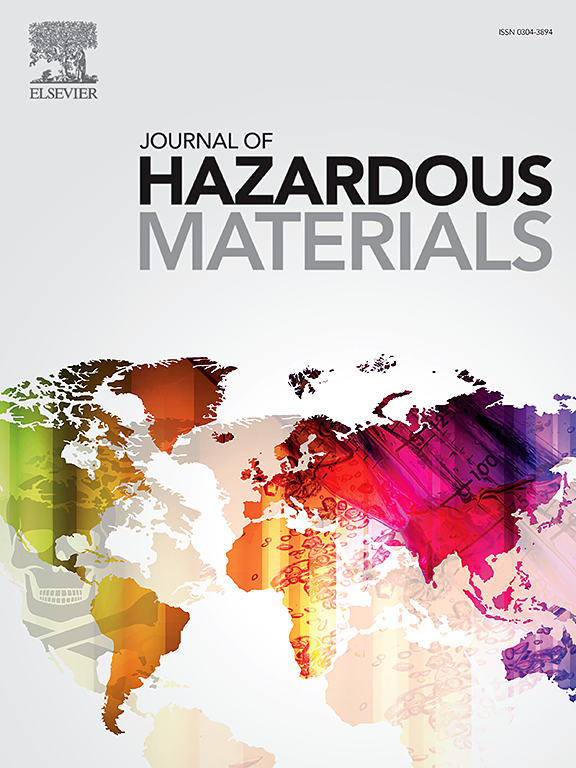Edge nucleation and bridging effect synergistically in-situ sealed multiple heavy metals in soils
IF 12.2
1区 环境科学与生态学
Q1 ENGINEERING, ENVIRONMENTAL
引用次数: 0
Abstract
The development of broad-spectrum remediation materials for soil heavy metals is an urgent problem in the environmental field. This study utilized oxygen-sulfur synergy sites in sulfonated cellulose/chitosan self-assembled gel (SMCG), which exhibited high affinity for Cu(II) and Ni(II), to induce and construct Cu-Ni bimetallic sulfides in situ. Through coupling with edge nucleation of Pb(II), Zn(II), and Cd(II), five heavy metals (Cu(II), Ni(II), Pb(II), Zn(II), and Cd(II)) were immobilized over the long term. In soil experiments, SMCG achieved an average passivation efficiency exceeding 98 % (exhibiting optimal performance under a wide temperature range at a dosage of 10 wt% and moisture content between 40 % and 60 %) and demonstrated broad-spectrum remediation capability by inducing silicate nucleation of Pb(II), Zn(II), and Cd(II) and facilitating coprecipitation of Cu-Ni bimetallic sulfides. Notably, Ni(II) enhanced the stability of Cu-S bonds through electron-donating effects, maintaining high passivation efficiency even following 90 days of aging. In summary, a paradigm shift from “soil remediation via exogenous materials” to “material-driven soil self-healing” was realized by using degradable materials to fix heavy metals through an intrinsic nucleation mechanism of soil, thereby providing a new direction for the development of heavy metal remediation materials (mitigating the risk of soil salinization associated with excessive exogenous material introduction). Furthermore, the multi-mechanism coupling strategy offers novel insights and a theoretical foundation for developing materials to remediate complex heavy metal-contaminated sites.

边缘成核和桥接作用协同原位封闭土壤中多种重金属
开发土壤重金属的广谱修复材料是环境领域亟待解决的问题。本研究利用磺化纤维素/壳聚糖自组装凝胶(SMCG)中对Cu(II)和Ni(II)具有高亲和力的氧硫协同位点,原位诱导构建Cu-Ni双金属硫化物。通过与Pb(II)、Zn(II)和Cd(II)的边缘成核耦合,5种重金属(Cu(II)、Ni(II)、Pb(II)、Zn(II)和Cd(II))被长期固定。在土壤实验中,SMCG的平均钝化效率超过98 %(在宽温度范围内,用量为10 wt%,含水率在40 % ~ 60 %之间时表现最佳),并通过诱导Pb(II)、Zn(II)和Cd(II)的硅酸盐成核和促进Cu-Ni双金属硫化物的共沉淀表现出广谱修复能力。值得注意的是,Ni(II)通过给电子效应增强了Cu-S键的稳定性,即使在90天后也保持了较高的钝化效率。综上所述,通过土壤固有的成核机制,利用可降解材料固定重金属,实现了从“外源材料修复土壤”到“材料驱动土壤自愈”的范式转变,为重金属修复材料的发展提供了新的方向(减轻外源材料过量引入导致土壤盐碱化的风险)。此外,多机制耦合策略为开发修复复杂重金属污染场地的材料提供了新的见解和理论基础。
本文章由计算机程序翻译,如有差异,请以英文原文为准。
求助全文
约1分钟内获得全文
求助全文
来源期刊

Journal of Hazardous Materials
工程技术-工程:环境
CiteScore
25.40
自引率
5.90%
发文量
3059
审稿时长
58 days
期刊介绍:
The Journal of Hazardous Materials serves as a global platform for promoting cutting-edge research in the field of Environmental Science and Engineering. Our publication features a wide range of articles, including full-length research papers, review articles, and perspectives, with the aim of enhancing our understanding of the dangers and risks associated with various materials concerning public health and the environment. It is important to note that the term "environmental contaminants" refers specifically to substances that pose hazardous effects through contamination, while excluding those that do not have such impacts on the environment or human health. Moreover, we emphasize the distinction between wastes and hazardous materials in order to provide further clarity on the scope of the journal. We have a keen interest in exploring specific compounds and microbial agents that have adverse effects on the environment.
 求助内容:
求助内容: 应助结果提醒方式:
应助结果提醒方式:


